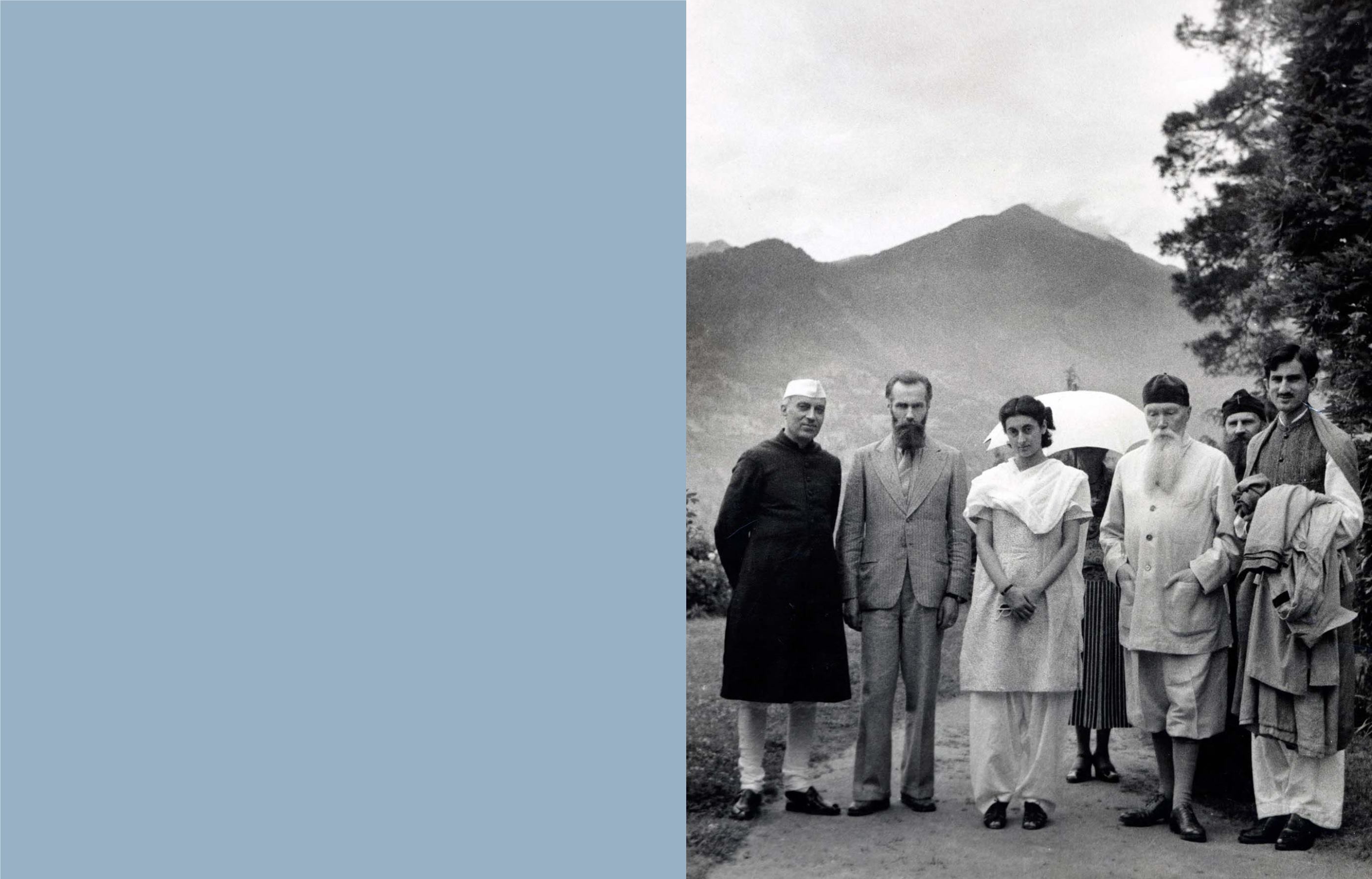

98
99
(Left to right): Jawaharlal Nehru, Svetoslav Roerich, Indira Gandhi, Nicholas Roerich, Helena Roerich (with umbrella), Naggar, India, 1942
Image courtesy of Nicholas Roerich Museum, New York
Roerich’s association with India began in his childhood, with
an old family painting of a majestic mountain that he admired.
He later discovered that it was the famous Kangchenjunga in
the Himalayan range, a mountain he would later trek to and
be inspired to paint. Quoting from the Chinese book,
Wei
Tsang T’u‒Shih
, in his diary in 1924, he writes, “The luster of
the mountain peaks is equal unto emerald. Verily the beauty
and perfection of all objects make this place incomparable.”
(
Altai‒Himalaya: A Travel Diary, Part I India
, New York: Nicholas
Roerich Museum, online)
Born Nicholas Konstantinovich Roerich on 9 October 1874 in
St. Petersburg, Russia, Roerich was raised in an upper middle‒
class family which interacted with influential people in Russia’s
vibrant art and cultural scene. He developed an interest in
archaeology and prehistoric artefacts, and showed a propensity
for drawing at a young age. He wished to pursue a career as an
artist, but his father, a lawyer, did not consider it an appropriate
profession. Eventually reaching a compromise, Roerich enrolled
simultaneously at the Academy of Art, and St. Petersburg
University to study law.
Over the next few years, Roerich immersed himself in the music,
arts and theatrical spaces of Russia. He served on the editorial
board of the
World of Art
magazine, a publication founded by
his contemporaries, and later was the secretary of the School
of the Society for the Encouragement of Art. During this time,
Roerich sought to revolutionise the system of art training by
bringing all the various fields of art under one roof, and giving
his faculty freedom to design their own curriculum. “The cross‒
fertilization of the arts that Roerich promoted was evidence
of his inclination to harmonize, bring together, and find
correspondences between apparent conflicts or opposites in all
areas of life. This was a hallmark of his thinking, and one sees it
demonstrated in all the disciplines he explored. He constantly
sought to break down compartmentalization, and, indeed, even
in his own art he defied categorization and created a universe
uniquely personal.” (Nicholas Roerich Museum, online)
By the first two decades of the 20
th
century, Roerich had
established himself as an eminent artist not just in Russia, but
in parts of Europe as well. At this time, a combination of factors
led the Roerichs, which included his wife Helena, and two sons
George and Svetoslav, to leave the country. With Roerich’s
deteriorating health, and the dangerous political atmosphere in
the years preceding the Russian Revolution of 1917 and World
War I, the Roerichs set for India.
Arriving in Bombay, (now Mumbai) in December 1923, the
artist and his family set upon a tour of India’s historic sites and
cultural centres and met with several artists, writers, scholars
and scientists including the Tagores and Bose Sen. Roerich kept
meticulous records of all the sights, the people he met and his
impressions of those encounters. Their journey culminated
in Sikkim, and it was evident that Roerich was drawn to the
spiritual and sociological elements of the culture in addition
to the physical magnificence of the Himalayan mountains. The
family continued on an expedition across Central Asia, covering
Chinese Turkestan, Altai, Mongolia and Tibet for the next five
years. Prompted by an anthropological interest in the “ancient
origins of human civilisation,” (Maria Zinger‒Golovkina,
“Painting. Late 19
th
to the early 20
th
century,” Irina Volchenkova
ed.,
Masterpieces of the State Tretyakov Gallery: Russian Art from
the 12
th
to early 20
th
century
, Moscow: Red Square Publishers, p.
114)—an intellectual and aesthetic curiosity that was evident
even in his earlier paintings of Russian landscapes, folklore and
mythology—Roerich’s aim was to study the life and culture of
these uncharted territories and its inhabitants.
The Roerichs eventually returned to India in 1928 and settled
in the Kullu Valley in the Himalayan foothills. Together they
founded the Urusvati Himalayan Research Institute, a centre
for the study of the Western Himalayas and adjacent regions,
which incorporated the learning from their expeditions.
Roerich’s Himalayan‒inspired art was deeply informed by a
sense of spiritual exploration. In many of the paintings from this
time, “we can see philosophical concepts and ideas giving birth
to visual images, and the splendor of Northern India providing
the physical setting.” (Nicholas Roerich Museum, online) His
paintings capture not only the physical magnificence and
ethereal atmosphere, but also evoke the spirit of the Himalayas,
as seen in the present lot. They are a symbolic reflection of his
own spiritual journey and the strength of character he acquired,
facing the physical challenges of his arduous expeditions.
Roerich is a highly revered figure internationally, and most of his
paintings are in public institutions in the US, Russia and India.
The present lot is a most significant, rare work to be offered at
auction in India.


















